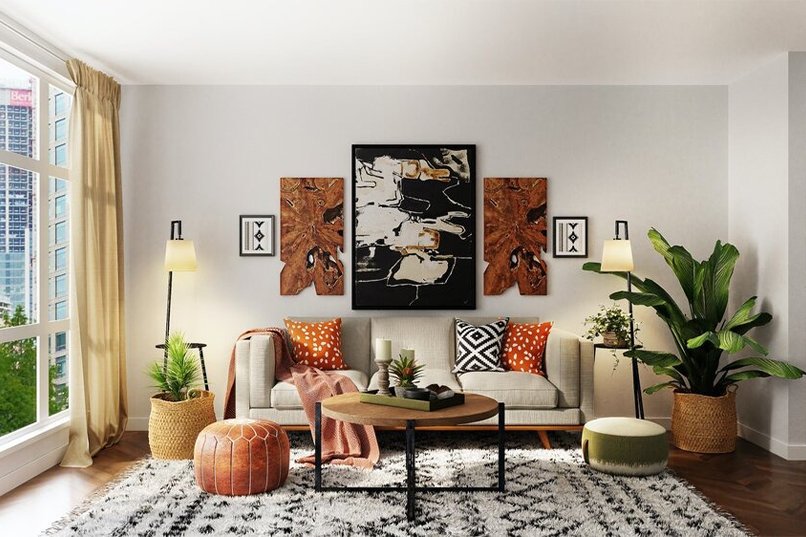
In the world of interior design, creating a visually arresting and inviting space goes beyond simply choosing furniture and colors. The art of layered interior design is mastering the interplay of texture and tone to add depth, warmth and personality to your living spaces. In this blog, we explore the transformative effects of texture and tone and show you how to master the art of layering for a home that feels rich, harmonious and beautifully curated.
Texture is the tactile quality of a surface and in interior design adds a sensual dimension to the visual appeal of a room. Whether it’s the softness of a plush carpet, the smoothness of polished wood or the roughness of textured walls, every surface contributes to the overall tactile experience of a room. Understanding texture is the first step to mastering the art of layering.

Texture plays a crucial role in creating depth in a space. In a well-layered home, combining different textures adds visual interest and dimension. Smooth surfaces can be juxtaposed with rough ones, creating a dynamic contrast that attracts the eye and evokes a feeling of richness. Consider incorporating textures into textiles, materials and finishes to create a layered and inviting atmosphere.
One of the most effective ways to add structure to your home is through fabrics and textiles. Experiment with a variety of materials such as soft velvet, cozy knits, smooth silk and natural linen. Layering different textiles on furniture, bedding and curtains not only increases visual interest but also adds a luxurious and tactile quality to your interior design.
The layering of materials with different tactile properties creates a contrast that enhances the overall design. Combine smooth surfaces such as glass or metal with structured elements such as reclaimed wood or stone. The interplay of contrasting materials gives your room depth and fascination and makes it visually dynamic and appealing.
Bringing nature indoors is a timeless approach to adding structure to your interior design. Consider incorporating natural elements like woven rattan, jute, or raw wood. These materials not only provide structure, but also provide a feeling of organic warmth, creating a connection to the natural world in your living spaces.

Walls are a canvas for texture in interior design. Explore different wall treatments to add depth and interest. Consider textured wallpaper, reclaimed wood paneling, or textured paint. These elements create a backdrop that complements the furnishings and decor in your room, contributing to a layered and visually appealing atmosphere.
Rugs are versatile tools for adding texture and tone to your home. Opt for rugs with different textures, such as: B. Shaggy rugs for a cozy atmosphere or flat-weave rugs for a simpler look. Layering rugs, especially in open spaces, creates visual separation and defines specific areas within a room.
While texture adds a tactile dimension, tone focuses on the visual aspect of layering. Tone is the lightness or darkness of a color. Mastering the art of layered interior design requires playing with a range of hues. The strategic use of color tones creates contrast, highlights focal points and ensures a cohesive color palette throughout the room.
Layering tones involves incorporating different hues to create depth and interest. Instead of relying on just one color, experiment with its lighter and darker variations. For example, in a neutral color scheme, include tones like soft beige, warm taupe, and rich chocolate brown. This tonal variation adds nuance and complexity to your interior design.
A monochromatic color scheme is a powerful tool for layering hues. Choose a base color and layer different shades and tones of that color throughout your space. From furniture to decor accents, a monochromatic approach creates a harmonious and sophisticated look. Add texture to the monochromatic palette to enhance the layered effect.

Contrasting hues create a visual impact and draw attention to specific elements in your interior design. Combining light and dark tones such as white and charcoal or beige and navy creates a striking contrast that defines rooms and highlights important features. Consider contrasting tones in furniture, wall colors, or decorative items to create a dynamic and visually compelling effect.
Balancing warm and cool tones is essential for a harmonious layered look. Warm tones such as red, yellow and orange convey coziness and vibrancy, while cool tones such as blue and green convey a feeling of calm and elegance. Incorporate both warm and cool tones into your space to create a balanced and inviting atmosphere.
Decorative accents are powerful tools for layering texture and tone. Explore a variety of accessories like throw pillows, vases and artwork to introduce different textures and tones. Consider combining metallic finishes like gold and silver for added dimension. Decorative accents serve as the finishing touches that tie the layers of your interior design together.
Layering allows you to create focal points in your space by strategically highlighting certain elements. Use contrasting tones and textures to draw attention to a specific area, such as: B. a fireplace, an accent wall or an eye-catching piece of furniture. Focal points anchor visual interest and add meaning to your eclectic interior design.